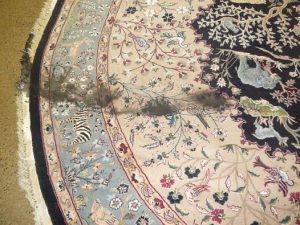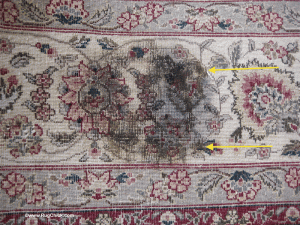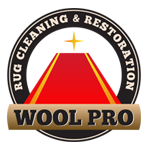 Carpet mold is a very serious issue because it can cause health problems, particularly for those with asthma, mold allergies, or resporatory ailments. In addition, carpet mold leads to a musty odor which makes the inside of a home unpleasant even for those whose health is unaffected.
Carpet mold is a very serious issue because it can cause health problems, particularly for those with asthma, mold allergies, or resporatory ailments. In addition, carpet mold leads to a musty odor which makes the inside of a home unpleasant even for those whose health is unaffected.
The terms mold and mildew are often used interchangeably. They are indeed similar but not really the same. It is important to understand their similarities and differences before attempting to prevent their occurrence or to clean up or remediate after finding them in your home or business.Both organisms are a form of fungus. Mildew is actually a type of mold. They are members of a large variety of micro-organisms which include fungi, algae, rusts, yeasts, and bacteria. The ability to exist on just about any type of material (as long as there is organic material on it) gives micro-organisms the dubious distinction of being called the chief agents of deterioration.
 The color and texture of mold and mildew are also ways to help distinguish each of them. Active mold is usually red, green, blue, and black and tends to be fuzzy and slimy. Mildew is usually powdery and most commonly comes in gray and white.Mildew thrives on surfaces where moisture content is very high. Examples are ceilings, walls, floors, window sills, leather, and paper, etc. Mildew is usually the culprit in showers, bathtubs, sinks, and toilets. There is even a type of mildew that is specific to wool carpets and rugs! A certain type of mildew can be found as yellow spots on leaves or fruits.
The color and texture of mold and mildew are also ways to help distinguish each of them. Active mold is usually red, green, blue, and black and tends to be fuzzy and slimy. Mildew is usually powdery and most commonly comes in gray and white.Mildew thrives on surfaces where moisture content is very high. Examples are ceilings, walls, floors, window sills, leather, and paper, etc. Mildew is usually the culprit in showers, bathtubs, sinks, and toilets. There is even a type of mildew that is specific to wool carpets and rugs! A certain type of mildew can be found as yellow spots on leaves or fruits.
While mold can survive on non-living materials such as tile and plastic as well as on plants, mildew specifically seeks out animal and plant goods and is especially devastating to crops. Regardless of the particular organic material that may be present, neither mold nor mildew can resist surfaces where there is moisture. They both prosper in dark, humid, damp and poorly ventilated environments.
Causes Rug mold is caused by moisture in a carpet. When a rug is dry, mold spores have nothing to feed off of and remain dormant. When moisture is introduced, mold spores begin to grow and spread. More often than not, the most severe cases of carpet mold begin in one area of the carpet with a slower and less obvious leakage or seepage of water. Severe water damage is usually dried and carpet mold removal treatments are deployed promptly. Thus, mold has little time to take hold of the carpet. When the carpet owner is unaware of the problem, the mold can grow for a long time before the problem becomes obvious. In either case, beginning carpet mold removal processes immediately is extremely important in order to limit damage not only to the carpet, but to the floor, furniture, and even the air quality.
The first sign of a mildew problem in an oriental carpet is usually small circles of dark brown or black. This indicates that the carpet is an environment with excessive moisture. If the problem is not dealt with, the mildew infestation can spread quickly. Without both a change in the encironment and a thorough cleaning, the oriental carpet may end up being destroyed.
Cleaning Rug Stains
Before doing anything else, remove the rug from its current location. Move it somewhere that both cool and dry. If the weather is appropriate, consider placing the rug outside. Lay it on a clean plastic tarp in a sunny location. If the weather is rainy or unpredictable, create an appropriate environment indoors. Use newspapers to protect the floor and fans to circulate air.
Use a vacuum cleaner to remove as much mildew as possible from the carpet. Make sure to vacuum both sides. Dispose of the vacuum bag quickly, to prevent the spread of mildew spores. Alternatively, use a soft- bristle brush to gently clean the stained areas.
Combine lemon juice and salt and apply this mixture to the affected ares. After 30 minutes, carefully scrub away the mixture. Vacuum up any leftover liquid. Create another mixture of 1/2 of white vinegar, 3 cups of warm water and teaspoon of unscented dish soap. Use a brush to thoroughly and gently wash away the stain. Carefully apply a clean cloth to the area to dry it. Then wait for the rug to become completely dry. If a stain remains, repeat this process.
Baking soda can be used to help draw remaining moisture out of the carpet. This is especially recommended if drying the carpet in the sun is impossible due to weather. Even after the stains have been completely removed, applying baking soda is generally advisable. The absorbing qualities of baking soda will remove any lingering odors. Allow the baking soda do sit on the carpet for up to twho days. Then vacuum it up. Baking soda can be safely applied multiple times if the odor is not eliminates.
Wearing gloves, glasses and a protective breathing mask during this process can ensure that on is not exposed to mildew spores.
Preventing mildew growth
If oriental carpets are kept in properly cared for environments, mildew will not grow. Make sure that the moisture level is not too high. Check to see if the roof leaks or it plumbing problems exist, and repair as needed. Some homes, especially those in damp climates, might require the use of air conditioners or dehumidifiers to ensure a safe environment for delicate rugs.
After any mildew infestation, continue to check on the affected rugs. Consider establishing a schedule to ensure that the rugs are regularly examined. While any oriental carpet may be affected by mildew, those that have had problems in the past are more likely to be reinfested.
With proper care, oriental rugs can last a long time. If the above steps do not help, consult a qualified professional.
There are hundreds of issues your beloved Oriental rugs can run into, and dry rot is among the worst of them. Mold, mildew, and dry rot all fall under the same category of a particular type of fungi damage, but they all vary in terms of severity.
Once your rug has hit the stage of dry rot, its foundation fibers have already started to deteriorate and it’ll continue to fall apart. The good news is mold and mildew can potentially be removed from your rug if caught early enough.
Dry rot appears dark in color, feels extremely stiff to the touch sounds like wood if you knock on it, cracks and disintegrates when bent, and can appear as a large, dusty hole.
What caused it? Moisture issues are the cause of mold, mildew, and dry rotting problems. Too much or too little moisture can be detrimental to your Oriental rug. Some of the most common rug damage caused by too much moisture is from flooding, a humid climate with little to no evaporation taking place due to a barrier ( ex: plastic), pet accidents, or over watering a potted plant that leaks out in result. Since liquid seeps through a rug and rests at the bottom of it, it’s easier to see these types of spots from the backside. Too little moisture in rugs that can cause fungus problems are commonly caused by direct sunlight over an extended period of time, age, high heat, or a buildup of cleaning residue.
It’s important that i explain a couple of these in depth, so you can gain some insight on why and how they can be so damaging. With pet urine, the alkaline salts within it can keep the fibers of your rug moist much longer compared to regular water, which creates a higher risk for damage.
With cleaning products, this tends to happen most often when people try to clean their rugs on their own and end up not rinsing them out properly. It’s extremely important to be confident in the way you clean your Oriental rigs, otherwise it’s best to get it professionally cleaned. Also, when cleaning, if a whitening product is used on cotton rug fringe, it can be too harsh for the fibers and cause premature dry rot and start to deteriorate as well.
Let’s move on to what can be done in hopes of saving your rugs from these types of problems. First off, it’s a good idea to evaluate your house and look for water sources near any of the rugs you own to see if it’s possible to rearrange them farther away from the water source. By doing this, you’ll be able to prevent any future damage to your rugs that you want to try and avoid altogether. Also, it’s a good idea to rotate your rugs every couple of months, especially is they are in the sunlight, so they wear evenly and not drastically in one spot. Keep in mind that sanitizing your rug if it has pet urine on it is always a smart choice to avoid potential mold problems in the future.
If your rug has mildew or mold on it, your best option is to use a sanitizing product on it before it gets cleaned. This will kill the fungi within your rug and stop it from spreading. All of it will be washed away once it’s cleaned and rinsed out. For dry rot, the side effects can be slowed down by using petroleum or keratin based products. These will help out with the stiffness of your rug and make it less able to crack. Again, dry rot is irreversible, but these types of products will help soften the textiles again. Be sure to avoid harsh chemicals when cleaning, especially on the fringe, to avoid having it fall out if it gets damaged by it. If you get your rug professionally cleaned, always let them know the condition of your rug so it can be accommodated in the appropriate way.
